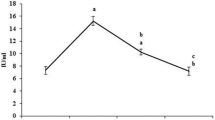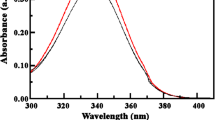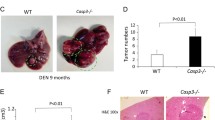Abstract
We evaluated the effects of dipyrido [3,2-a:2′,3′-c] phenazine (dppz) Au(III) complex ([Au(dppz)Cl2]Cl) on apoptosis during chemically induced hepatocellular carcinoma. 48 male Spraque-Dawley rats were divided into six groups; group I (control), group II [Dimethyl sulfoxide (DMSO)], group III ([Au(dppz)Cl2]Cl), group IV [diethylnitrosamine + Phenobabital (DEN + PB)], group V (DEN + PB + [Au(dppz)Cl2]Cl (2nd week)), and group VI (DEN + PB + [Au(dppz)Cl2]Cl (7th week). The rats in groups IV through VI were administrated with DEN in a single dose of intraperitoneal 175 mg/kg. After 2 weeks of DEN administration, these groups of rats were given daily PB in a dose of 500 ppm. In group V, after two weeks of DEN administration, [Au(dppz)Cl2]Cl complex (2 mg/kg) was given once a week by intraperitoneal injection. In the group VI, the rats were given a dose of 2 mg/kg [Au(dppz)Cl2]Cl complex once a week, 7 weeks after DEN administration. At the end of the study, blood and tissue samples were collected from the rats to determine levels of serum AST, ALT, and LDH, and caspase 3, p53, Bax, Bcl-2 and DNA fragmentation in liver. AST, ALT, LDH, and Bcl-2 levels were higher in group IV, compared to group I, but caspase 3 and p53 levels were lower. In group V, caspase 3, p53, Bax, and DNA fragmentation levels were higher than those of group IV. Caspase 3 and p53 levels increased in group VI compared with group IV. In conclusion, [Au(dppz)Cl2]Cl complex induced apoptosis by elevating levels of caspase 3, p53, Bax, and DNA fragmentation.







Similar content being viewed by others
Abbreviations
- dppz:
-
Dipyrido [3,2-a:2′,3′-c] phenazine
- [Au(dppz)Cl2]Cl:
-
Dipyrido [3,2-a:2′,3′-c] phenazine (dppz) Au(III)
- DMSO:
-
Dimethyl sulfoxide
- DEN:
-
Diethylnitrosamine
- PB:
-
Phenobarbital
- Cisplatin:
-
Cis-diammine-dichloroplatinum (II)
- HCC:
-
Hepatocellular carcinoma
- TUNEL:
-
Terminal deoxynucleotidyl transferase biotin-dUTP nick end labeling
- LD50:
-
50 % Lethal dose
- SPSS:
-
Statistical package for the social sciences
References
Frezza M, Hindo S, Chen D, Davenport A, Schmitt S, Tomco D, Dou QP (2010) Novel metals and metal complexes as platforms for cancer therapy. Curr Pharm Des 16:1813–1825
Chen D, Milacic V, Frezza M, Dou QP (2009) Metal complexes, their cellular targets and potential for cancer therapy. Curr Pharm Des 15:777–791
Yan YK, Melchart M, Habtemariam A, Sadler PJ (2005) Organometallic chemistry, biology and medicine: ruthenium arene anticancer complexes. Chem Commun (Camb) 14:4764–4776
Lum CT, Yang ZF, Li HY, Wai-Yin Sun R, Fan ST, Poon RT, Lin MC, Che CM, Kung HF (2006) Gold(III) compound is a novel chemocytotoxic agent for hepatocellular carcinoma. Int J Cancer 118:1527–1538
Wahl K, Siegemund M, Lehner F, Vondran F, Nüssler A, Länger F, Krech T, Kontermann R, Manns MP, Schulze-Osthoff K, Pfizenmaier K, Bantel H (2013) Increased apoptosis induction in hepatocellular carcinoma by a novel tumor-targeted TRAIL fusion protein combined with bortezomib. Hepatology 57:625–636
McKeage MJ, Maharaj L, Berners-Price SJ (2002) Mechanisms of cytotoxicity and antitumor activity of gold (I) phosphine complexes: the possible role of mitochondria. Coord Chem Rev 232:127–135
Casini A, Hartinger C, Gabbiani C, Mini E, Dyson PJ, Keppler BK, Messori L (2008) Gold(III) compounds as anticancer agents: relevance of gold-protein interactions for their mechanism of action. J Inorg Biochem 102:564–575
Palanichamy K, Sreejayan N, Ontko AC (2012) Overcoming cisplatin resistance using gold(III) mimics: anticancer activity of novel gold(III) polypyridyl complexes. J Inorg Biochem 106:32–42
Giovagnini L, Ronconi L, Aldinucci D, Lorenzon D, Sitran S, Fregona D (2005) Synthesis, characterization, and comparative in vitro cytotoxicity studies of platinum(II), palladium(II), and gold(III) methylsarcosinedithiocarbamate complexes. J Med Chem 48:1588–1595
Aldinucci D, Lorenzon D, Stefani L, Giovagnini L, Colombatti A, Fregona D (2007) Antiproliferative and apoptotic effects of two new gold(III) methylsarcosinedithiocarbamate derivatives on human acute myeloid leukemia cells in vitro. Anti Cancer Drugs 18:323–332
Ronconi L, Giovagnini L, Marzano C, Bettìo F, Graziani R, Pilloni G, Fregona D (2005) Gold dithiocarbamate derivatives as potential antineoplastic agents: design, spectroscopic properties, and in vitro antitumor activity. Inorg Chem 44:1867–1881
Ronconi L, Marzano C, Zanello P, Corsini M, Miolo G, Maccà C, Trevisan A, Fregona D (2006) Gold(III) dithiocarbamate derivatives for the treatment of cancer: solution chemistry, DNA binding, and hemolytic properties. J Med Chem 49:1648–1657
Maruyama T, Sonokawa S, Matsushita H, Goto M (2007) Inhibitiory effects of gold(III) ions on ribonuclease and deoxyribonuclease. J Inorg Biochem 101:180–186
Carotti S, Guerri A, Mazzei T, Messori L, Mini E, Orioli P (1998) Gold(III) compounds as potential antitumor agents: cytotoxicity and DNA binding properties of some selected polyamine-gold(III) complexes. Inorganica Chim Acta 281:90–94
Zhang CX, Lippard SJ (2003) New metal complexes as potential therapeutics. Curr Opin Chem Biol 7:481–489
Vela L, Contel M, Palomera L, Azaceta G, Marzo I (2011) Iminophosphorane–organogold(III) complexes induce cell death through mitochondrial ROS production. J Inorg Biochem 105:1306–1313
Ding HF, Lin YL, McGill G, Juo P, Zhu H, Blenis J, Yuan J, Fisher DE (2000) Essential role for caspase-8 in transcription-independent apoptosis triggered by p53. J Biol Che 275:38905–38911
Brito AF, Abrantes AM, Pinto-Costa C, Gomes AR, Mamede AC, Casalta-Lopes J, Gonçalves AC, Sarmento-Ribeiro AB, Tralhão JG, Botelho MF (2012) Hepatocellular carcinoma and chemotherapy: the role of p53. Chemotherapy 58:381–386
Lai PB, Chi TY, Chen GG (2007) Different levels of p53 induced either apoptosis or cell cycle arrest in a doxycycline-regulated hepatocellular carcinoma cell line in vitro. Apoptosis 12:387–393
Macejova D, Britko J (2001) Chemically induced carcinogenesis: a comparison of 1-methyl-1-nitrosourea, 7,12-dimethyl benzanthracene, diethylnitroso-amine and azoxymethan models. Endocr Regul 35:53–59
Dickeson JE, Summers LA (1970) Derivatives of 1,10-Phenanthroline-5,6-quinone. Aust J Chem 23:1023–1027
Marcon G, Carotti S, Coronnello M, Messori L, Mini E, Orioli P, Mazzei T, Cinellu MA, Minghetti G (2002) Gold(III) complexes with bipyridyl ligands: solution chemistry, cytotoxicity, and DNA binding properties. J Med Chem 45:1672–1677
Cusumano M, Di Pietro ML, Giannetto A (2006) DNA interaction of platinum(II) complexes with 1,10-phenanthroline and extended phenanthrolines. Inorg Chem 45:230–235
Palanichamy K, Ontko AC (2006) Synthesis, characterization, and aqueous chemistry of cytotoxic Au(III) polypyridyl complexes. Inorganica Chim Acta 359:44–52
McConnell AA, Brown DH, Smith WE (1981) The vibrational properties of some gold(iii)-halide complexes. Spectrochim Acta, Part A 37:583–585
Finney DJ (1952) Probit analysis, 2nd edn. Cambridge University Press, New York
Ustuner MC, Degirmenci I, Kiran I, Ozden H, Civi K, Ustuner D, Gunes HV (2008) The protective effects of demethoxyviridine and 1-alpha-hydroxy-demethoxyviridine in the livers of male rats treated with diethylnitrosamine and 2-acetylaminflourene. Saudi Med J 29:1241–1246
Kakehashi A, Inoue M, Wei M, Fukushima S, Wanibuchi H (2009) Cytokeratin 8/18 overexpression and complex formation as an indicator of GST-P positive foci transformation into hepatocellular carcinomas. Toxicol Appl Pharmacol 238:71–79
Tirkey N, Kaur G, Vij G, Chopra K (2005) Curcumin, a diferuloylmethane, attenuates cyclosporine-induced renal dysfunction and oxidative stress in rat kidneys. BMC Pharmacol 5:15
Schattenberg JM, Schuchmann M, Galle PR (2011) Cell death and hepatocarcinogenesis: dysregulation of apoptosis signaling pathways. J Gastroenterol Hepatol 1:213–219
Lu X, Qian J, Zhou H, Gan Q, Tang W, Lu J, Yuan Y, Liu C (2011) In vitro cytotoxicity and induction of apoptosis by silica nanoparticles in human HepG2 hepatoma cells. Int J Nanomedicine 6:1889–1901
Tu S, Wai-Yin Sun R, Lin MC, Tao Cui J, Zou B, Gu Q, Kung HF, Che CM, Wong BC (2009) Gold (III) porphyrin complexes induce apoptosis and cell cycle arrest and inhibit tumor growth in colon cancer. Cancer 115:4459–4469
Shi P, Jiang Q, Zhao Y, Zhang Y, Lin J, Lin L, Ding J, Guo Z (2006) DNA binding properties of novel cytotoxic gold(III) complexes of terpyridine ligands: the impact of steric and electrostatic effects. J Biol Inorg Chem 11:745–752
Magherini F, Modesti A, Bini L, Puglia M, Landini I, Nobili S, Mini E, Cinellu MA, Gabbiani C, Messori L (2010) Exploring the biochemical mechanisms of cytotoxic gold compounds: a proteomic study. J Biol Inorg Chem 15:573–582
Milacic V, Chen D, Ronconi L, Landis-Piwowar KR, Fregona D, Dou QP (2006) A novel anticancer gold(III) dithiocarbamate compound inhibits the activity of a purified 20S proteasome and 26S proteasome in human breast cancer cell cultures and xenografts. Cancer Res 66:10478–10486
Bishayee A, Dhir N (2009) Resveratrol-mediated chemoprevention of diethylnitrosamine-initiated hepatocarcinogenesis: inhibition of cell proliferation and induction of apoptosis. Chem Biol Interact 179:131–144
Chakraborty T, Chatterjee A, Rana A, Srivastawa S, Damodaran S, Chatterjee M (2007) Cell proliferation and hepatocarcinogenesis in rat initiated by diethylnitrosamine and promoted by phenobarbital: potential roles of early DNA damage and liver metallothionein expression. Life Sci 81:489–499
Ha WS, Kim CK, Song SH, Kang CB (2001) Study on mechanism of multistep hepatotumorigenesis in rat: development of hepatotumorigenesis. J Vet Sci 2:53–58
Kalaiselvan A, Gokulakrishnan K, Anand T, Akhilesh U, Velavan S (2013) Preventive effect of Shorea robusta bark extract against diethylnitrosamine-induced hepatocellular carcinoma in rats. Int Res J Medical Sci 1:2–9
Song Y, Jin SJ, Cui LH, Ji XJ, Yang FG (2013) Effect of Stichopus japonicus acid mucopolysaccharide on experimental hepatocellular carcinoma in rats. Molecules 18:7179–7193
Ramakrishnan G, Augustine TA, Jagan S, Vinodhkumar R, Devaki T (2007) Effect of silymarin on N-nitrosodiethylamine induced hepatocarcinogenesis in rats. Exp Oncol 29:39–44
Hsu YL, Kuo PL, Lin CC (2004) Proliferative inhibition, cell-cycle dysregulation, and induction of apoptosis by ursolic acid in human non-small cell lung cancer A549 cells. Life Sci 75:2303–2316
Ramakrishnan G, Lo Muzio L, Elinos-Báez CM, Jagan S, Augustine TA, Kamaraj S, Anandakumar P, Devaki T (2009) Silymarin inhibited proliferation and induced apoptosis in hepatic cancer cells. Cell Prolif 42:229–240
Palanichamy K, Sreejayan N, Ontko AC (2012) Overcoming cisplatin resistance using gold(III) mimics: anticancer activity of novel gold(III) polypyridyl complexes. J Inorg Biochem 106:32–42
Monga J, Pandit S, Chauhan RS, Chauhan CS, Chauhan SS, Sharma M (2013) Growth inhibition and apoptosis induction by (+)- Cyanidan-3-ol in hepatocellular carcinoma. PLoS One 8:e68710
Huang H, Zhang XF, Zhou HJ, Xue YH, Dong QZ, Ye QH, Qin LX (2010) Expression and prognostic significance of osteopontin and caspase-3 in hepatocellular carcinoma patients after curative resection. Cancer Sci 101:1314–1319
Persad R, Liu C, Wu TT, Houlihan PS, Hamilton SR, Diehl AM, Rashid A (2004) Overexpression of caspase-3 in hepatocellular carcinomas. Mod Pathol 7:861–867
Saraswati S, Alhaider AA, Agrawal SS (2013) Anticarcinogenic effect of brucine in diethylnitrosamine initiated and phenobarbital-promoted hepatocarcinogenesis in rats. Chem Biol Interact 206:214–221
Santini D, Tonini G, Vecchio FM, Borzomati D, Vincenzi B, Valeri S, Antinori A, Castri F, Coppola R, Magistrelli P, Nuzzo G, Picciocchi A (2005) Prognostic value of Bax, Bcl-2, p53, and TUNEL staining in patients with radically resected ampullary carcinoma. J Clin Pathol 58:159–165
Handayani T, Sakinah S, Nallappan M, Pihie AH (2007) Regulation of p53, Bcl-2 and caspase dependent signaling pathway in xanthorrhizol-induced apoptosis of HepG2 hepatoma cells. Anticancer Res 27:965–971
Nandy A, Dey SK, Das S, Munda RN, Dinda J, Saha KD (2014) Gold (I) N-heterocyclic carbene complex inhibits mouse melanoma growth by p53 upregulation. Mol Cancer 13:57
Yu J, Zhou X, He X, Dai M, Zhang Q (2011) Curcumin induces apoptosis involving bax/bcl-2 in human hepatoma SMMC-7721 cells. Asian Pac J Cancer Prev 12:1925–1929
Henkels KM, Turchi JJ (1999) Cisplatin-induced apoptosis proceeds by caspase-3-dependent and independent pathways in cisplatin resistant and sensitive human ovarian cancer cell lines. Cancer Res 59:3077–3083
Akcali KC, Sahiner M, Sahiner T (2005) The role of bcl-2 family of genes during kindling. Epilepsia 46:217–223
Elmore S (2007) Apoptosis: a review of programmed cell death. Toxicol Pathol 35:495–516
Sakinah SA, Handayani ST, Hawariah LP (2007) Zerumbone induced apoptosis in liver cancer cells via modulation of Bax/Bcl-2 ratio. Cancer Cell Int 7:4
Roy AM, Baliga MS, Elmets CA, Katiyar SK (2005) Grape seed proanthocyanidins induce apoptosis through p53, Bax, and caspase 3 pathways. Neoplasia 7:24–36
Acknowledgments
This study was supported by Eskisehir Osmangazi University Scientific Research Commission. Contract grants number 201011044.
Author information
Authors and Affiliations
Corresponding author
Rights and permissions
About this article
Cite this article
Tekin, N., Ustuner, M.C., Akyuz, F. et al. Apoptotic effects of dipyrido [3,2-a:2′,3′-c] phenazine (dppz) Au(III) complex against diethylnitrosamine/phenobarbital induced experimental hepatocarcinogenesis in rats. Mol Biol Rep 41, 5109–5121 (2014). https://doi.org/10.1007/s11033-014-3376-2
Received:
Accepted:
Published:
Issue Date:
DOI: https://doi.org/10.1007/s11033-014-3376-2




